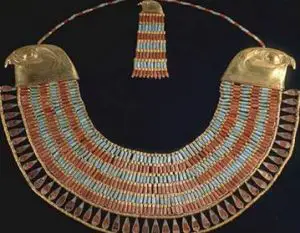The Climate of Ancient Egypt, due to its proximity to the desert and the Nile, was very hot and humid. Thus less clothing was preferred, in most cases. Ancient Egyptian attire, with the exception of nobility’s garments, was simple and unadorned. To make up for this simplicity in clothing, Ancient used various Egyptian Accessories and beauty products.
The simple white pleated clothing was often richly enhanced with wide collars made of shells, beads, flowers, and precious stones set in gold – a style that originated during the Old Kingdom. Colour and wealth were displayed through Egyptian Accessories, mainly jewellery, which both men and women wore. Other, accessories used by the Egyptians included headdresses and wigs, ornaments and makeup and stylish footwear.
Different Egyptian Accessories
Hair and head-dresses
Hair styles indicated a person’s status and position. For example, Children’s hair was usually short with a long strand falling from the right-hand side of the head. Married women often wore shoulder-length locks, which framed the face while the rest of the hair fell down the back of the head. Premarital women and young servant girls sometimes held their hair with ringlets to either side of the face.
Wigs were worn by both men and women. They had both a functional and aesthetic purpose. Because of the heat and the habitual preoccupation with cleanliness, people usually shaved their heads. While the nobility wore wigs made of real hair, the poor wore wigs made of wool.
Men wore wigs mainly for religious events. Women’s wigs reached their greatest proportions in the New Kingdom, falling below the shoulder and featuring ornate Egyptian Accessories such as gold bands and rings, coloured glass and jewels. Ptolemy Queen, Cleopatra is known to have possessed wigs in several hair shades.
Hair could be either concealed or revealed by a head-dress. The ubiquitous fabric head-dress, the bulky klaft, primarily served to protect the wearer from the heat of the sun. Made from a thick material, it was fixed at the temples and fell in folds over the shoulders.
The most famous of ancient Egyptian headgear were the pharaohs’ crowns, such as the red crown of Lower Egypt, the towering white crown of Upper Egypt, the double crown of united Egypt (i.e. the combined red and white crowns), and the blue crown of battle.
Jewellery and ornaments
Jewellery was part of ancient Egyptian wardrobe since the early Egyptians had mastered the art of jewellery making. Necklaces, armlets, bracelets, and anklets were made of gold, coral, pearl, agate, onyx, and chalcedony.

Accessories also had religious or political significance. Silver was the considered to be a substance which made up gods’ bones and was mainly used for religious ornamentation. And so was the ankh, which was a sacred sign of life. Flowers were often used as adornment, not only for their beauty but also for their sacred qualities. These were often used in religious ceremonies.
The pharaohs’ regalia were highly symbolic. The cobra, worn on both the crown and the hood-like head-dress, was a symbol exclusive to kings in Egypt. The crook and flail represented authority over the land and the people. Amulets, such as scarab beetles, were worn in life and then buried with the dead for protection.
Footwear
Prior to the 9th century B.C., there almost no evidence of footwear being used either kings or priests or in depictions of deities. However, by 814 B.C., sandals appeared. They consisted of two straps and a sole and protected the feet from the hot desert sand while keeping them cool.
Both men and women wore the same type of sandals, made in a coiled technique using grass and clean palm leaves, papyrus, wood, and goat skin. Shoes were for indoor wear; they would be carried during a journey, and put on when a party arrived at their destination.
Grooming and Makeup
Hygiene was very important in ancient Egypt, in part due to the local climate and living conditions. Egyptians followed strict grooming regimes, often dictated by decrees. They had their skin exfoliated, rubbed their bodies with oils, body scrubs, or incense, cleaned their teeth by chewing the root of Salvadoran Persia, and kept their breath fresh by gargling with milk and chewing herbs.
Both men and women wore makeup. Women lightened their skin with a yellow ochre colour. Men used orange-tinted paint to darken their facial skin. Black Kohl or green malachite powder was used to underline the eyes. Eyebrows were enhanced with grey powder. Red lip gloss was mixed from fat and ochre. Rouge was also popular.
Make-up and perfumes were made and sold by priests who kept their formulas secret. They extracted the scent from plants and flowers by steeping them in oil to create an essential oil. The substance was stored in cloth and later tightly wrung to collect the perfume drops.
